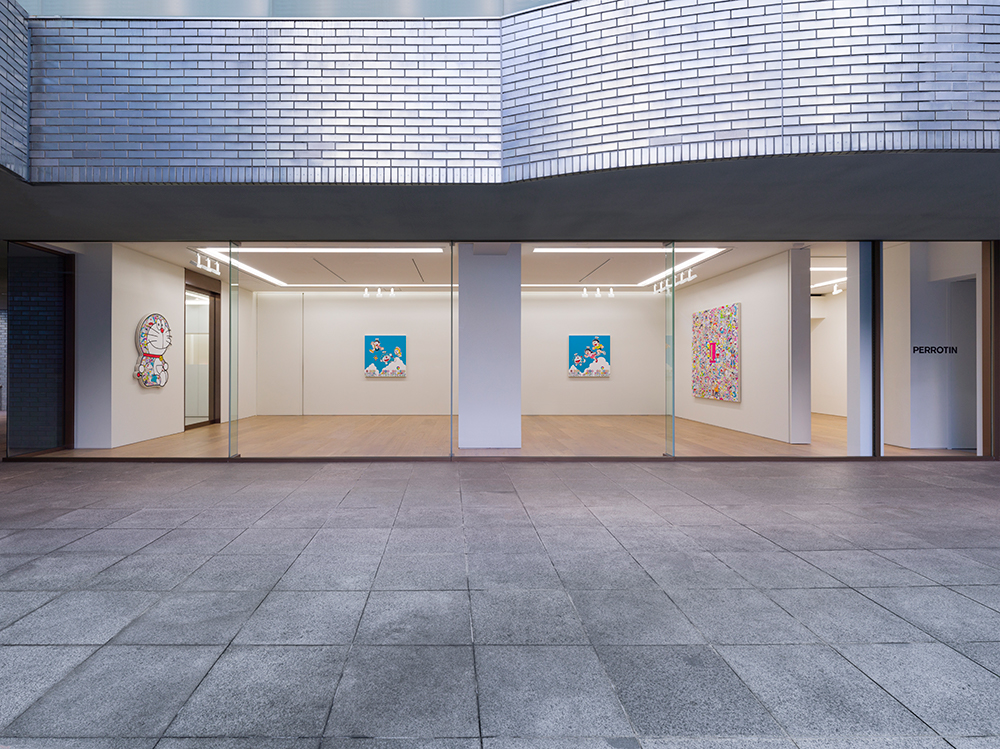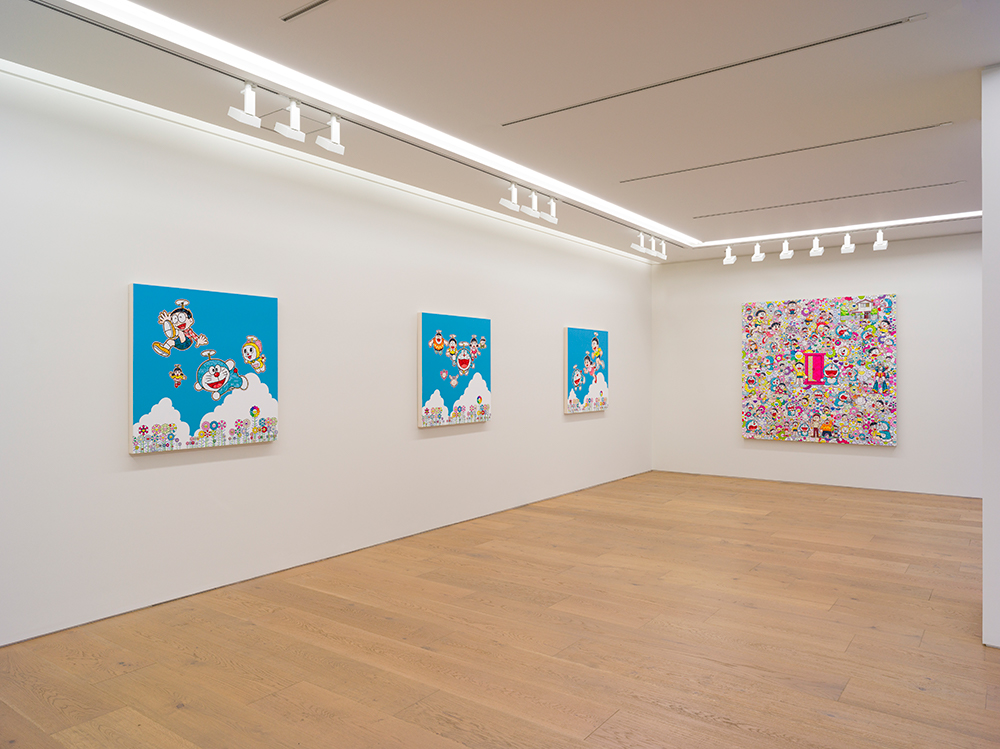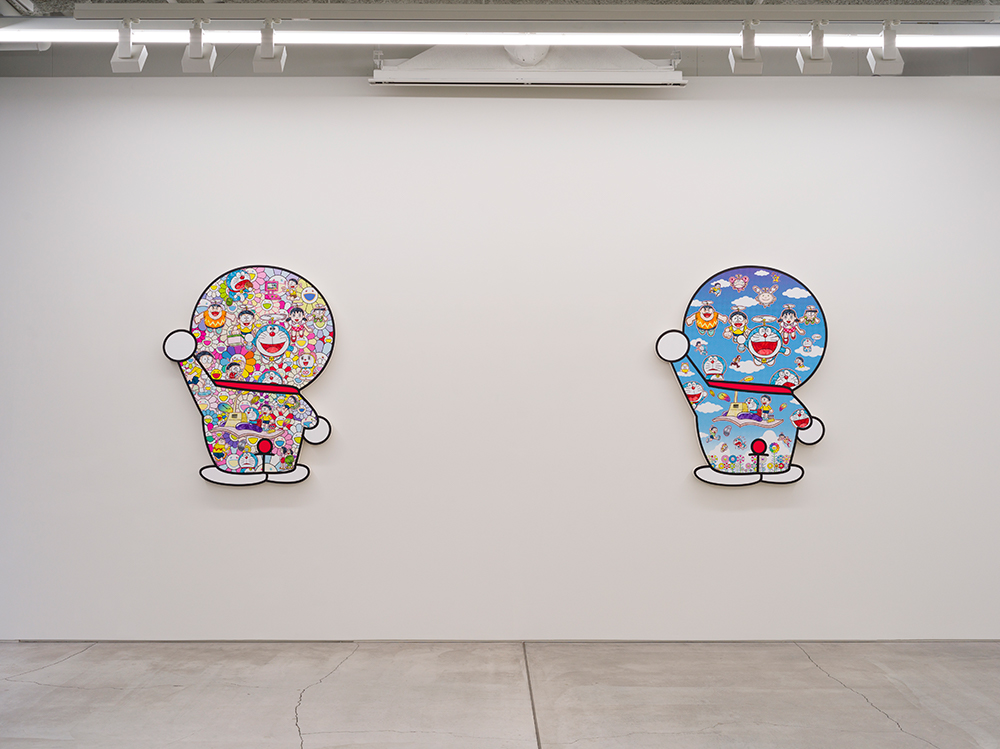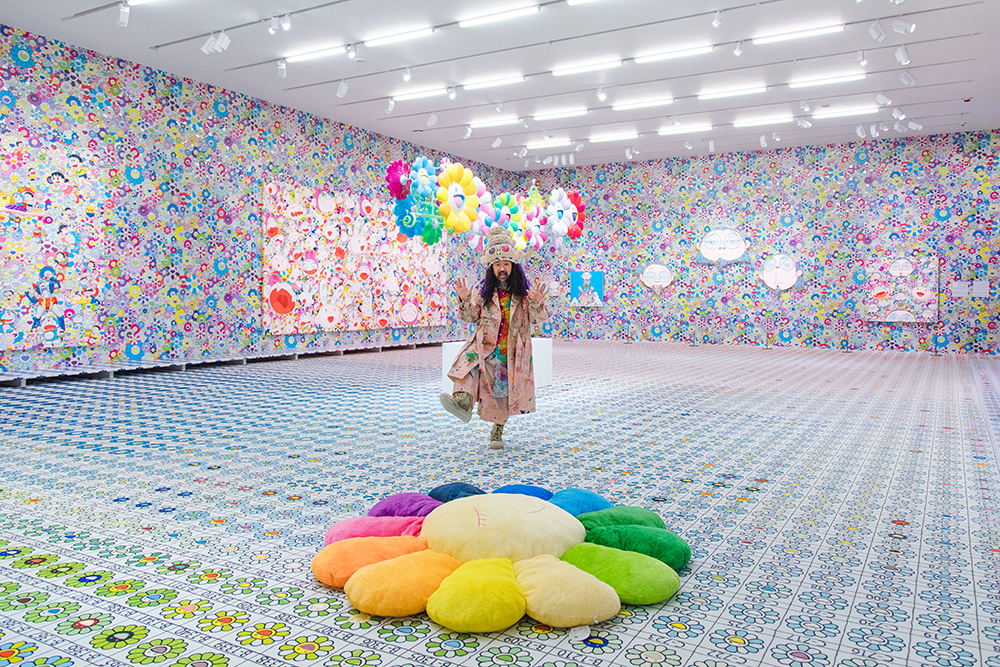At a casual glance, the new works by celebrated pop artist Takashi Murakami now on exhibit at Perrotin Gallery in Roppongi display collages of innocuous images of characters from the classic Japanese manga series Doraemon engulfed in Murakami’s ubiquitous trademark flowers.
The smiles of the colorful anthropomorphic blossoms match that of the cartoon’s namesake, Doraemon, the robot cat from the future sent to help the dimwitted and lazy, yet kind-hearted, Nobita Nobi overcome his travails.

©︎ 2019 Takashi Murakami/Kaikai Kiki Co., Ltd. All Rights Reserved. ©︎ Fujiko-Pro. Photographer: Kei Okano
The showcase piece of the Superflat Doraemon collaborative exhibition is the massive painting, A Sketch of Anywhere Door and an Excellent Day. In the manga series, Doraemon characters use the anywhere door to be whisked away to their desired location. In the painting, the door at the focal point is consumed by jumbled images of Doraemon scenes and Murakami’s glossy flowers, a Japanese method called iji douzu hou, in which consecutive events are conveyed in one picture.
The prominent, idyllic images show Doraemon and Nobi in exultation and exuberance. Meanwhile, the secondary images run the gamut of emotions from pain and shock to peace and happiness. One image shows Doraemon sitting in a lotus position eating sweets. In another scene Doraemon is whacked over the head with a mallet. One shows an enraged Doraemon blasting away with a hand cannon. In another he appears bamboozled, or tipsy.
The jubilant Doraemon scenes become the focus of three separate paintings, and as if to hit the viewer over the head with obviousness, Murakami gave these pieces such titles as “So Much Fun, Under the Blue Sky” and “A Blue Sky, We Could Go On Forever!”

©︎ 2019 Takashi Murakami/Kaikai Kiki Co., Ltd. All Rights Reserved. ©︎ Fujiko-Pro. Photographer: Kei Okano
Each character depicted in Murakami’s Superflat Doraemon series is optimistically moving forward, or is mired in a present situation defined by a physical predicament, such as hunger or fisticuffs.
If you look closely at these brand-new acrylic works painted on canvas and mounted on aluminum frames (three of the pieces were delivered the morning of the exhibition launch), you can see that not all of the flowers smile. Some flowers are shocked. Some flowers cry.
Murakami has long said that his flowers smile to hide the pain, representing the face Japanese people wore to hide the despair following the 1945 atomic bombings of Hiroshima and Nagasaki. Along with the flowers, Murakami’s purposeful use of blue, a color preferred by some contemporary Japanese artists because of its soothing and calming abilities, also draws viewers into a false sense of contentment.
The abstract expressionism of the Tokyo native and son of a taxicab driver has been compared to Andy Warhol, a comparison that is just as lazy as Nobita Nobi. While both artists depict pop culture icons to create a pretense of almost crazed happiness, Warhol’s beauties had glaring frailties and lives filled with tragedy. The devout Catholic, like many American artists, was more fixated on the division between good and evil.
Murakami has a PhD in nihonga – Japanese painting – from Tokyo University of Arts, and studied Buddhist Edo Era painters such as Soga Shohaku. The demon in Shohaku’s painting of the Buddhist parable of Session Doji-zu delivers the message, “All is changeable, nothing is constant.”
It would be hard to maintain that Murakami’s work is about obtaining nirvana, but his works do blur the definitions of good and bad – just like the actions and behaviors of Nobita Nobi.
The works on display at Perrotin Tokyo appear to be more interested in depicting self-inflicted struggles and the sidesteps that subtly reveal the failures, as well as the past successes, banal moments and violent conflicts, we are so desperate to hide. Murakami also takes time to celebrate unbridled joy.
He is unable to rein in his innate playfulness with the painting simply titled Love, in which Doraemon snuggles with a cute white cat with a pink bow. After all, for those of us facing everyday obstacles, some which are temporary, some debilitating, a robot cat from the future isn’t going to come save us. Though, you can always go hug a cat.

©︎ 2019 Takashi Murakami/Kaikai Kiki Co., Ltd. All Rights Reserved. ©︎ Fujiko-Pro. Photographer: Kei Okano
Murakami’s fixation with Doraemon dates back to his landmark 2005 exhibition, Little Boy, when Doreamon was included as one of the elements of this series of exhibitions and music events that interpreted Japan’s postwar art as a high-spirited escape from human tragedy.
The exhibition was launched a few years after Murakami coined the term superflat. A self-described manga geek, he was dissatisfied with the disdain shown toward commercial artwork – manga and anime in particular – amongst Japan’s art establishment.
He views the two-dimensional work of Japan’s traditional masters just the same as the work produced by Japan’s low culture artists, and thus believes the expression presented through all art – be it ukiyo-e or an advertisement – holds equal value.
This attitude has left Murakami at odds with the Japanese art world, but after being discovered by French contemporary art gallery owner Emmanuel Perrotin in the mid-‘90s, Murakami has been embraced by Western enthusiasts.
In 2002 he started a 13-year collaboration with Louis Vuitton at the invitation of designer Marc Jacobs and he designed the cover artwork for Kanye West’s 2007 album Graduation. Murakami is good friends with DJ and producer Steve Aoki, who made a special appearance at the Perrotin Gallery exhibition launch party.

Takashi Murakami at Uniqlo’s store in New York City. Photo: Uniqlo ©Takashi Murakami/Kaikai Kiki Co., Ltd. All Rights Reserved. ©Fujiko-Pro
The pieces in the Superflat Doraemon exhibition exude the skill and technique of a master at his craft, yet are not groundbreaking or nearly as satirical as Murakami’s early works, such as The Little Boy series, which was named after the nuclear bomb dropped on Hiroshima.
Shortly after Little Boy, he was asked to contribute a piece to Doraemon creator Fujiko F. Fujio’s Please make your own Doraemon exhibition. According to art journalist Yoshio Suzuki, Murakami said at the time that his submission was created from his memory of an early summer in the 1970s, when he played with his brother in the empty lots of Tokyo’s industrial area.
Murakami created the main visual for The Doraemon Exhibition Tokyo 2017, and in the last two years his works have featured in Oslo, Chicago, Moscow, Vancouver and Hong Kong. He also designed Uniqlo T-shirts.
Perhaps success has slowed Murakami’s drive to push boundaries and thumb his nose at the art establishment. He is, after all, the artist who once painted a smile on a mushroom cloud. But as his first solo exhibition at Perrotin Tokyo makes clear, his work is still relevant, and he still has the ability to deliver an emotional punch through seemingly benign subjects.
Feature image: Takashi Murakami at “MURAKAMI vs MURAKAMI” in JC Contemporary, Tai Kwun. Photography: Alex Maeland ©2019 Takashi Murakami/Kaikai Kiki Co., Ltd. All Rights Reserved.









